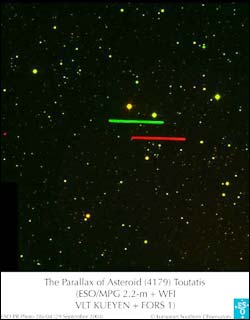ESO Views of Earth-Approaching Asteroid Toutatis

Today, September 29, 2004, is undisputedly the Day of Toutatis, the famous “doomsday” asteroid.
Not since the year 1353 did this impressive “space rock” pass so close by the Earth as it does today. Visible as a fast-moving faint point of light in the southern skies, it approaches the Earth to within 1,550,000 km, or just four times the distance of the Moon. Closely watched by astronomers since its discovery in January 1989, this asteroid has been found to move in an orbit that brings it close to the Earth at regular intervals, about once every four years. This happened in 1992, 1996, 2000 and now again in 2004.
Radar observations during these passages have shown that Toutatis has an elongated shape, measuring about 4.6 x 2.4 x 1.9 km. It tumbles slowly through space, with a rotation period of 5.4 days. The above images of Toutatis were taken with the ESO Very Large Telescope (during a technical test) in the evening of September 28. They were obtained just over 12 hours before the closest approach that happens today at about 15:40 hrs Central European Summer Time (CEST), or 13:40 hrs Universal Time (UT). At the time of these observations, Toutatis was about 1,640,000 km from the Earth, moving with a speed of about 11 km/sec relative to our planet.
They show the asteroid as a fast-moving object of magnitude 10, about 40 times fainter than what can be perceived with the unaided, dark-adapted eye. They also prove that Toutatis is right on track, following exactly the predicted trajectory in space and passing the Earth at a safe distance, as foreseen. Detailed calculations, taking into account all available observations of this celestial body, have shown that although Toutatis passes regularly near the Earth, today’s passage is the closest one for quite some time, at least until the year 2562. The ESO observations, obtained at a moment when Toutatis was very close to the Earth, will help to further refine the orbital calculations.
The “parallax effect” demonstrated!
Simultaneous images obtained with telescopes at ESO’s two observatories at La Silla and Paranal demonstrate the closeness of Toutatis to the Earth. As can be seen on the unique ESO PR Photo 28e/04 that combines two of the exposures from the two observatories, the sighting angle to Toutatis from the two observatories, 513 km km apart, is quite different. Astronomers refer to this effect as the “parallax”. The closer the object is, the larger is the effect, i.e., the larger will be the shift of the line-of-sight.
Interestingly, the measured angular distance in the sky of the beginning and end of the two trails (about 40 arcsec), together with the known distance between the two observatories and the position of Toutatis in the sky at the moment of the exposures fully define the triangle “Paranal-Toutatis-La Silla” and thus allow to calculate the exact distance to the asteroid.
It is found to be very close to that predicted from the asteroid’s position in its orbit and that of the Earth at the moment of this unique observation, 1,607,900 km. This exceptional, simultaneous set of observations thus provides an independent measurement of Toutatis’ distance in space and, like the measured positions, a confirmation of its computed orbit. More information about Toutatis is available at the dedicated webpage by the French discoverers and also at the specialised Near-Earth Objects – Dynamic Site.
The full text of this ESO PR Photo release, with five photos and all weblinks, is available at the above adress:
Media Contact
All latest news from the category: Physics and Astronomy
This area deals with the fundamental laws and building blocks of nature and how they interact, the properties and the behavior of matter, and research into space and time and their structures.
innovations-report provides in-depth reports and articles on subjects such as astrophysics, laser technologies, nuclear, quantum, particle and solid-state physics, nanotechnologies, planetary research and findings (Mars, Venus) and developments related to the Hubble Telescope.
Newest articles

Pinpointing hydrogen isotopes in titanium hydride nanofilms
Although it is the smallest and lightest atom, hydrogen can have a big impact by infiltrating other materials and affecting their properties, such as superconductivity and metal-insulator-transitions. Now, researchers from…

A new way of entangling light and sound
For a wide variety of emerging quantum technologies, such as secure quantum communications and quantum computing, quantum entanglement is a prerequisite. Scientists at the Max-Planck-Institute for the Science of Light…

Telescope for NASA’s Roman Mission complete, delivered to Goddard
NASA’s Nancy Grace Roman Space Telescope is one giant step closer to unlocking the mysteries of the universe. The mission has now received its final major delivery: the Optical Telescope…



